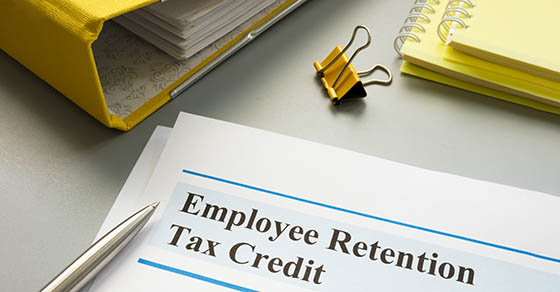Weekly Tax Brief
Why you might want to file early and answers to other tax season questions
- Details
- Published: 26 January 2023 26 January 2023

The IRS announced it opened the 2023 individual income tax return filing season on January 23. That’s when the agency began accepting and processing 2022 tax year returns. Even if you typically don’t file until much closer to the mid-April deadline (or you file for an extension), consider filing earlier this year. The reason is you can potentially protect yourself from tax identity theft.
Here are some answers to questions taxpayers may have about filing.
How can your tax identity be stolen?
In a typical tax identity theft scam, a thief uses another individual’s personal information to file a fraudulent tax return early in the filing season and claim a bogus refund.
The actual taxpayer discovers the fraud when he or she files a return and is told by the IRS that the return is being rejected because one with the same Social Security number has already been filed for the tax year. Ultimately, the taxpayer should be able to prove that his or her return is the legitimate one, but tax identity theft can be time consuming and frustrating to straighten out. It can also delay a refund.
Your best defense may be to file early. Why? If you file first, the tax return filed by a potential thief will be rejected.
What are this year’s deadlines?
This year, the filing deadline to submit 2022 returns or file an extension is Tuesday, April 18 for most taxpayers. The due date is April 18, instead of April 15, because the 15th falls on a weekend and the District of Columbia’s Emancipation Day holiday falls on Monday, April 17.
If you’re requesting an extension, you’ll have until October 16, 2023, to file. Keep in mind that an extension of time to file your return doesn’t grant you any extension of time to pay your taxes. You should estimate and pay any taxes owed by the regular deadline to help avoid penalties.
When will your W-2s and 1099s arrive?
To file your tax return, you need all of your Form W-2s and 1099s. January 31 is the deadline for employers to issue 2022 W-2s to employees and, generally, for businesses to issue Form 1099s to recipients of any 2022 interest, dividend or reportable miscellaneous income payments (including those made to independent contractors).
If you haven’t received a W-2 or 1099 by February 1, first contact the entity that should have issued it. If that doesn’t work, ask us how to proceed.
Are there any other advantages to filing early?
In addition to protecting yourself from tax identity theft, another advantage of early filing is that, if you’re getting a refund, you’ll get it sooner. The IRS expects most refunds to be issued within 21 days. The time may be shorter if you file electronically and receive a refund by direct deposit into a bank account.
Direct deposit also avoids the possibility that a refund check could be lost, stolen, returned to the IRS as undeliverable or caught in mail delays.
Need assistance?
If you have questions or would like an appointment to prepare your return, please contact us. We can help ensure you file an accurate return and receive all of the tax breaks to which you’re entitled.
© 2023
Forms W-2 and 1099-NEC are due to be filed soon
- Details
- Published: 24 January 2023 24 January 2023

With the 2023 filing season deadline drawing near, be aware that the deadline for businesses to file information returns for hired workers is even closer. By January 31, 2023, employers must file these forms:
Form W-2, Wage and Tax Statement. W-2 forms show the wages paid and taxes withheld for the year for each employee. They must be provided to employees and filed with the Social Security Administration (SSA). The IRS notes that “because employees’ Social Security and Medicare benefits are computed based on information on Form W-2, it’s very important to prepare Form W-2 correctly and timely.”
Form W-3, Transmittal of Wage and Tax Statements. Anyone required to file Form W-2 must also file Form W-3 to transmit Copy A of Form W-2 to the SSA. The totals for amounts reported on related employment tax forms (Form 941, Form 943, Form 944 or Schedule H for the year) should agree with the amounts reported on Form W-3.
Failing to timely file or include the correct information on either the information return or statement may result in penalties.
Independent contractors
The January 31 deadline also applies to Form 1099-NEC, Nonemployee Compensation. These forms are provided to recipients and filed with the IRS to report non-employee compensation to independent contractors.
Payers must complete Form 1099-NEC to report any payment of $600 or more to a recipient.
If the following four conditions are met, you must generally report payments as nonemployee compensation:
- You made a payment to someone who isn’t your employee,
- You made a payment for services in the course of your trade or business,
- You made a payment to an individual, partnership, estate, or, in some cases, a corporation, and
- You made payments to a recipient of at least $600 during the year.
Your business may also have to file a Form 1099-MISC for each person to whom you made certain payments for rent, medical expenses, prizes and awards, attorney’s services and more.
We can help
If you have questions about filing Form W-2, Form 1099-NEC or any tax forms, contact us. We can assist you in staying in compliance with all rules.
© 2023
Tax-saving ways to help pay for college — once your child starts attending
- Details
- Published: 19 January 2023 19 January 2023

If you have a child or grandchild in college — congratulations! To help pay for the expenses, many parents and grandparents saved for years in tax-favored accounts, such as 529 plans. But there are also a number of tax breaks that you may be able to claim once your child begins attending college or post-secondary school.
Tuition tax credits
You can take the American Opportunity Tax Credit (AOTC) of up to $2,500 per student for the first four years of college — a 100% credit for the first $2,000 in tuition, fees, and books, and a 25% credit for the second $2,000. You can take a Lifetime Learning Credit (LLC) of up to $2,000 per family for every additional year of college or graduate school — a 20% credit for up to $10,000 in tuition and fees.
The AOTC is 40% refundable up to $1,000 (meaning you can get a refund if the credit amount is greater than your tax liability). Both credits are phased out for married couples filing jointly with modified adjusted gross income (MAGI) between $160,000 and $180,000, and for singles with MAGI between $80,000 and $90,000.
Only one credit can be claimed per eligible student in any given year. To claim the education tax credits, a taxpayer must receive a Form 1098-T statement from the school. Other rules may apply.
Scholarships
Scholarships are exempt from income tax if certain conditions are satisfied. The most important is that the scholarship generally can’t be compensation for services, and it must be used for tuition, fees, books and supplies (not for room and board).
However, a tax-free scholarship reduces the amount of expenses that may be taken into account in computing the AOTC and LLC and may reduce or eliminate those credits.
Employer educational assistance
If your employer pays your child’s college expenses, the payment is a fringe benefit, and is taxable to you as compensation, unless it’s part of a scholarship program that’s “outside of the pattern of employment.” Then, the payment will be treated as a scholarship (if the requirements for scholarships are satisfied).
Tuition payments by grandparents and others
If someone gives you money to pay your child’s college expenses, the person is generally subject to gift tax, to the extent the payments exceed the annual exclusion of $17,000 per recipient for 2023. Married donors who split gifts may exclude gifts of up to $34,000 for 2023.
However, if the person (say, a grandparent) pays your child’s tuition directly to an educational institution, there’s an unlimited exclusion from gift tax for the payment. This unlimited gift tax exclusion applies only to direct tuition costs (not room and board, books, supplies, etc.).
Retirement account withdrawals
You can take money out of your IRA or Roth IRA any time to pay college costs without incurring the 10% early withdrawal penalty that usually applies to distributions before age 59½. However, the distributions are subject to tax under the usual IRA rules.
You also may be able to borrow against your employer retirement plan or take withdrawals from it to pay for college. But before you do so, make sure you understand the tax implications, including any penalties that you may incur.
Plan ahead
Not all of the above breaks may be used in the same year, and some of them reduce the amounts that qualify for other breaks. So it takes planning to determine which should be used in any given situation. Contact us if you’d like to discuss any of the above options, or other alternatives.
How the new SECURE 2.0 law may affect your business
- Details
- Published: 17 January 2023 17 January 2023

If your small business has a retirement plan, and even if it doesn’t, you may see changes and benefits from a new law. The Setting Every Community Up for Retirement Enhancement 2.0 Act (SECURE 2.0) was recently signed into law. Provisions in the law will kick in over several years.
SECURE 2.0 is meant to build on the original SECURE Act, which was signed into law in 2019. Here are some provisions that may affect your business.
Retirement plan automatic enrollment. Under the new law, 401(k) plans will be required to automatically enroll employees when they become eligible, beginning with plan years after December 31, 2024. Employees will be permitted to opt out. The initial automatic enrollment amount would be at least 3% but not more than 10%. Then, the amount would be increased by 1% each year thereafter until it reaches at least 10%, but not more than 15%. All current 401(k) plans are grandfathered. Certain small businesses would be exempt.
Part-time worker coverage. The first SECURE Act requires employers to allow long-term, part-time workers to participate in their 401(k) plans with a dual eligibility requirement (one year of service and at least 1,000 hours worked or three consecutive years of service with at least 500 hours worked). The new law will reduce the three-year rule to two years, beginning after December 31, 2024. This provision would also extend the long-term part-time coverage rules to 403(b) plans that are subject to ERISA.
Employees with student loan debt. The new law will allow an employer to make matching contributions to 401(k) and certain other retirement plans with respect to “qualified student loan payments.” This means that employees who can’t afford to save money for retirement because they’re repaying student loan debt can still receive matching contributions from their employers into retirement plans. This will take effect beginning after December 31, 2023.
“Starter” 401(k) plans. The new law will allow an employer that doesn’t sponsor a retirement plan to offer a starter 401(k) plan (or safe harbor 403(b) plan) that would require all employees to be default enrolled in the plan at a 3% to 15% of compensation deferral rate. The limit on annual deferrals would be the same as the IRA contribution limit with an additional $1,000 in catch-up contributions beginning at age 50. This provision takes effect beginning after December 31, 2023.
Tax credit for small employer pension plan start-up costs. The new law increases and makes several changes to the small employer pension plan start-up cost credit to incentivize businesses to establish retirement plans. This took effect for plan years after December 31, 2022.
Higher catch-up contributions for some participants. Currently, participants in certain retirement plans can make additional catch-up contributions if they’re age 50 or older. The catch-up contribution limit for 401(k) plans is $7,500 for 2023. SECURE 2.0 will increase the 401(k) catch-up contribution limit to the greater of $10,000 or 150% of the regular catch-up amount for individuals ages 60 through 63. The increased amounts will be indexed for inflation after December 31, 2025. This provision will take effect for taxable years beginning after December 31, 2024. (There will also be increased catch-up amounts for SIMPLE plans.)
Retirement savings for military spouses. SECURE 2.0 creates a new tax credit for eligible small employers for each military spouse that begins participating in their eligible defined contribution plan. This became effective in 2023.
These are only some of the provisions in SECURE 2.0. Contact us if you have any questions about your situation.
© 2023
Tax-wise ways to save for college
- Details
- Published: 12 January 2023 12 January 2023

If you’re a parent or grandparent with college-bound children, you may want to save to fund future education costs. Here are several approaches to take maximum advantage of the tax-favored ways to save that may be available to you.
Savings bonds
Series EE U.S. savings bonds offer two tax-saving opportunities when used to finance college expenses:
- You don’t have to report the interest on the bonds for federal tax purposes until the bonds are cashed in, and
- Interest on “qualified” Series EE (and Series I) bonds may be exempt from federal tax if the bond proceeds are used for qualified college expenses.
To qualify for the college tax exemption, you must purchase the bonds in your own name (not the child’s) or jointly with your spouse. The proceeds must be used for tuition, fees, etc. — not room and board. If only some proceeds are used for qualified expenses, only that part of the interest is exempt.
If your modified adjusted gross income (MAGI) exceeds certain amounts, the exemption is phased out. For bonds cashed in 2023, the exemption begins to phase out when joint MAGI hits $137,800 for married joint filers ($91,850 for other returns) and is completely phased out if MAGI is $167,800 or more for joint filers ($106,850 or more for others).
Qualified tuition programs or 529 plans
Typically known as a “529 plans,” these programs allow you to buy tuition credits or make contributions to an account set up to meet a child’s future higher education expenses. 529 plans are established by state governments or private institutions.
Contributions aren’t deductible and are treated as taxable gifts to the child. But they’re eligible for the annual gift tax exclusion ($17,000 in 2023). A donor who contributes more than the annual exclusion limit for the year can elect to treat the gift as if it were spread out over a five-year period.
Earnings on the contributions accumulate tax-free until the college costs are paid from the funds. Distributions from 529 plans are tax-free to the extent the funds are used to pay “qualified higher education expenses,” which can include up to $10,000 in tuition for an elementary or secondary school. Distributions of earnings that aren’t used for “qualified higher education expenses” are generally subject to income tax plus a 10% penalty.
Coverdell education savings accounts (ESAs)
You can establish a Coverdell ESA and make contributions of up to $2,000 for each child under age 18. This age limitation doesn’t apply to beneficiaries with special needs.
The right to make contributions begins to phase out once AGI is over $190,000 on a joint return ($95,000 for single taxpayers). If the income limit is an issue, the child can make a contribution to his or her own account.
Although contributions aren’t deductible, income in the account isn’t taxed, and distributions are tax-free if spent on qualified education expenses. If the child doesn’t attend college, the money must be withdrawn when the child turns 30 and any earnings will be subject to tax plus a penalty. However, unused funds can be transferred tax-free to a Coverdell ESA of another member of the family who hasn’t reached age 30. The age 30 requirement doesn’t apply to individuals with special needs.
We can help
These are just some of the tax-favored ways to save a college fund for your children. In a future article, we’ll discuss possible tax breaks once your child is already in college. Contact us if you wish to discuss these issues.
© 2023
Employers should be wary of ERC claims that are too good to be true
- Details
- Published: 10 January 2023 10 January 2023

The Employee Retention Credit (ERC) was a valuable tax credit that helped employers that kept workers on staff during the height of the COVID-19 pandemic. While the credit is no longer available, eligible employers that haven’t yet claimed it might still be able to do so by filing amended payroll returns for tax years 2020 and 2021.
However, the IRS is warning employers to beware of third parties that may be advising them to claim the ERC when they don’t qualify. Some third-party “ERC mills” are promising that they can get businesses a refund without knowing anything about the employers’ situations. They’re sending emails, letters and voice mails as well as advertising on television. When businesses respond, these ERC mills are claiming many improper write-offs related to taxpayer eligibility for — and computation of — the credit.
These third parties often charge large upfront fees or a fee that’s contingent on the amount of the refund. They may not inform taxpayers that wage deductions claimed on the companies’ federal income tax returns must be reduced by the amount of the credit.
According to the IRS, if a business filed an income tax return deducting qualified wages before it filed an employment tax return claiming the credit, the business should file an amended income tax return to correct any overstated wage deduction. Your tax advisor can assist with this.
Businesses are encouraged to be cautious of advertised schemes and direct solicitations promising tax savings that are too good to be true. Taxpayers are always responsible for the information reported on their tax returns. Improperly claiming the ERC could result in taxpayers being required to repay the credit along with penalties and interest.
ERC Basics
The ERC is a refundable tax credit designed for businesses that:
- Continued paying employees while they were shut down due to the COVID-19 pandemic, or
- Had significant declines in gross receipts from March 13, 2020, to September 30, 2021 (or December 31, 2021 for certain startup businesses).
Eligible taxpayers could have claimed the ERC on an original employment tax return or they can claim it on an amended return.
To be eligible for the ERC, employers must have:
- Sustained a full or partial suspension of operations due to orders from an appropriate governmental authority limiting commerce, travel, or group meetings due to COVID-19 during 2020 or the first three quarters of 2021,
- Experienced a significant decline in gross receipts during 2020 or a decline in gross receipts during the first three quarters of 2021, or
- Qualified as a recovery startup business for the third or fourth quarters of 2021.
As a reminder, only recovery startup businesses are eligible for the ERC in the fourth quarter of 2021. Additionally, for any quarter, eligible employers cannot claim the ERC on wages that were reported as payroll costs in obtaining Paycheck Protection Program (PPP) loan forgiveness or that were used to claim certain other tax credits.
How to Proceed
If you didn’t claim the ERC, and believe you’re eligible, contact us. We can advise you on how to proceed.
© 2023
SECURE 2.0 law may make you more secure in retirement
- Details
- Published: 06 January 2023 06 January 2023

A new law was recently signed that will help Americans save more for retirement, although many of the provisions don’t kick in for a few years. The Setting Every Community Up for Retirement Enhancement 2.0 Act (SECURE 2.0) was signed into law on December 29, 2022.
SECURE 2.0 is meant to build on the original SECURE Act of 2019, which made major changes to the required minimum distribution (RMD) rules and other retirement provisions.
Here are some of the significant retirement plan changes and when they’ll become effective:
- The age for beginning RMDs is going up. Employer-sponsored qualified retirement plans, traditional IRAs and individual retirement annuities are subject to RMD rules. They require that benefits start being distributed by the required beginning date. Under the new law, the age distributions must begin increases from age 72 to age 73 starting on January 1, 2023. It will then increase to age 75 starting on January 1, 2033.
- There will be higher “catch-up” contributions for 401(k) participants ages 60 through 63. Currently, participants in certain retirement plans can make additional catch-up contributions if they’re age 50 or older. The limit on catch-up contributions to 401(k) plans is $7,500 for 2023. SECURE 2.0 will increase the 401(k) plan catch-up contribution limits for individuals ages 60 through 63 to the greater of $10,000 or 150% of the regular catch-up amount. The increased amounts will be indexed for inflation after 2025. This provision will take effect for taxable years beginning after December 31, 2024. (There will also be increased catch-up amounts for SIMPLE plans.)
- Tax-free rollovers will be allowed from 529 accounts to Roth IRAs. SECURE 2.0 will permit beneficiaries of 529 college savings accounts to make direct trustee-to-trustee rollovers from a 529 accounts in their names to their Roth IRAs without tax or penalty. Several rules apply. This provision is effective for distributions after December 31, 2023.
- “Matching” contributions will be permitted for employees with student loan debt. The new law will allow an employer to make matching contributions to 401(k) and certain other retirement plans with respect to “qualified student loan payments.” The result of this provision is that employees who can’t afford to save money for retirement because they’re repaying student loan debt can still receive matching contributions from their employers into retirement plans. This will take effect beginning after December 31, 2023.
Non-retirement plan provision
There are also some parts of the law that aren’t related to retirement plans, including a change to Achieving a Better Life Experience (ABLE) accounts. Tax-exempt ABLE programs are established by states to assist individuals with disabilities. Currently, in order to be the beneficiary of an ABLE account, an individual’s disability or blindness must have occurred before age 26. SECURE 2.0 increases this age limit to 46, which will make more people eligible to benefit from an ABLE account. This provision is effective for tax years beginning after December 31, 2025.
Just the beginning
These are only some of the many provisions in SECURE 2.0. Contact us if you have any questions about your situation.
© 2023
The standard business mileage rate is going up in 2023
- Details
- Published: 03 January 2023 03 January 2023

Although the national price of gas is a bit lower than it was a year ago, the optional standard mileage rate used to calculate the deductible cost of operating an automobile for business will be going up in 2023. The IRS recently announced that the 2023 cents-per-mile rate for the business use of a car, van, pickup or panel truck is 65.5 cents. These rates apply to electric and hybrid-electric automobiles, as well as gasoline and diesel-powered vehicles.
In 2022, the business cents-per-mile rate for the second half of the year (July 1 – December 31) was 62.5 cents per mile, and for the first half of the year (January 1 – June 30), it was 58.5 cents per mile.
How rate calculations are done
The 3-cent increase from the 2022 midyear rate is somewhat surprising because gas prices are currently lower than they have been. On December 29, 2022, the national average price of a gallon of regular gas was $3.15, compared with $3.52 a month earlier and $3.28 a year earlier, according to AAA Gas Prices. However, the standard mileage rate is calculated based on all the costs involved in driving a vehicle — not just the price of gas.
The business cents-per-mile rate is adjusted annually. It’s based on an annual study commissioned by the IRS about the fixed and variable costs of operating a vehicle, including gas, maintenance, repair and depreciation. Occasionally, if there’s a substantial change in average gas prices, the IRS will change the cents-per-mile rate midyear, as it did in 2022.
Standard rate versus actual expenses
Businesses can generally deduct the actual expenses attributable to business use of vehicles. This includes gas, oil, tires, insurance, repairs, licenses and vehicle registration fees. In addition, you can claim a depreciation allowance for the vehicle. However, in many cases, certain limits apply to depreciation write-offs on vehicles that don’t apply to other types of business assets.
The cents-per-mile rate is beneficial if you don’t want to keep track of actual vehicle-related expenses. With this method, you don’t have to account for all your actual expenses. However, you still must record certain information, such as the mileage for each business trip, the date and the destination.
Using the cents-per-mile rate is also popular with businesses that reimburse employees for business use of their personal vehicles. These reimbursements can help attract and retain employees who drive their personal vehicles a great deal for business purposes. Why? Under current law, employees can’t deduct unreimbursed employee business expenses, such as business mileage, on their own income tax returns.
If you do use the cents-per-mile rate, keep in mind that you must comply with various rules. If you don’t comply, the reimbursements could be considered taxable wages to the employees.
The standard rate can’t always be used
There are some cases when you can’t use the cents-per-mile rate. It partly depends on how you’ve claimed deductions for the same vehicle in the past. In other situations, it depends on if the vehicle is new to your business this year or whether you want to take advantage of certain first-year depreciation tax breaks on it.
As you can see, there are many factors to consider in deciding whether to use the standard mileage rate to deduct vehicle expenses. We can help if you have questions about tracking and claiming such expenses in 2023 — or claiming 2022 expenses on your 2022 income tax return.
© 2023
Save for retirement by getting the most out of your 401(k) plan
- Details
- Published: 23 December 2022 23 December 2022

Socking away money in a tax-advantaged retirement plan can help you reduce taxes and help secure a comfortable retirement. If your employer offers a 401(k) or Roth 401(k), contributing to the plan is a smart way to build a substantial nest egg.
If you’re not already contributing the maximum allowed, consider increasing your contribution. Because of tax-deferred compounding (tax-free in the case of Roth accounts), boosting contributions can have a major impact on the amount of money you’ll have in retirement.
With a 401(k), an employee makes an election to have a certain amount of pay deferred and contributed by an employer on his or her behalf to the plan. The amounts are indexed for inflation each year and not surprisingly, they’re going up quite a bit. The contribution limit in 2023 is $22,500 (up from $20,500 in 2022). Employees age 50 or older by year end are also permitted to make additional “catch-up” contributions of $7,500 in 2023 (up from $6,500 in 2022). This means those 50 and older can save a total of $30,000 in 2023 (up from $27,000 in 2022).
Contributing to a traditional 401(k)
A traditional 401(k) offers many benefits, including:
- Contributions are pretax, reducing your modified adjusted gross income (MAGI), which can also help you reduce or avoid exposure to the 3.8% net investment income tax.
- Plan assets can grow tax-deferred — meaning you pay no income tax until you take distributions.
- Your employer may match some or all of your contributions pretax.
If you already have a 401(k) plan, take a look at your contributions. In 2023, you may want to try and increase your contribution rate to get as close to the $22,500 limit (with an extra $7,500 if you’re age 50 or older) as you can afford. Keep in mind that your paycheck will be reduced by the amount of the contribution only, because the contributions are pretax — so, income tax isn’t withheld.
Contributing to a Roth 401(k)
Employers may also include a Roth option in their 401(k) plans. If your employer offers this, you can designate some or all of your contributions as Roth contributions. While such amounts don’t reduce your current MAGI, qualified distributions will be tax-free.
Roth 401(k) contributions may be especially beneficial for higher-income earners, because they don’t have the option to contribute to a Roth IRA. That’s because your ability to make a Roth IRA contribution is reduced or eliminated if your adjusted gross income exceeds certain amounts.
Looking ahead
Contact us if you have questions about how much to contribute or the best mix between traditional and Roth 401(k) contributions. We can also discuss other tax and retirement-saving strategies in your situation.
© 2022
How to minimize the S corporation LIFO recapture tax
- Details
- Published: 23 December 2022 23 December 2022

If you’re considering converting your C corporation to an S corporation, be aware that there may be tax implications if you’ve been using the last in, first out (LIFO) inventory method. That’s because of the LIFO recapture income that will be triggered by converting to S corporation status. We can meet to compute what the tax on this recapture would be and to see what planning steps might be taken to minimize it.
Inventory reporting
As you’re aware, your corporation has been reporting a lower amount of taxable income under LIFO than it would have under the first in, first out (FIFO) method. The reason: The inventory taken into account in calculating the cost of goods sold under LIFO reflects current costs, which are usually higher.
This benefit of LIFO over FIFO is equal to the difference between the LIFO value of inventory and the higher value it would have had if the FIFO method had been used. In effect, the tax law treats this difference as though it were profit earned while the corporation was a C corporation. To make sure there’s a corporate-level tax on this amount, it must be “recaptured” into income when the corporation converts from a C corporation to an S corporation. Also, the recapture amount will increase the corporation’s earnings and profits, which can have adverse tax consequences down the road.
Soften the blow
There are a couple of rules that soften the blow of this recapture tax to some degree.
- The increase in tax imposed on the C corporation in its final tax year because of the LIFO recapture may be paid over a four-year period.
- The basis of the corporation’s inventory will be increased by the amount of income recognized. So, the net effect may be one primarily of timing — because of the basis increase, the corporation may realize less income in later years, though only if there are decrements in the adjusted LIFO layer.
We can help you gauge your exposure to the LIFO recapture tax and can suggest strategies for reducing it. Contact us to discuss these issues in detail.
© 2022





